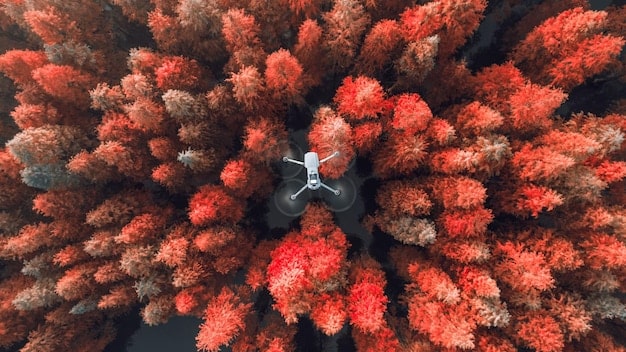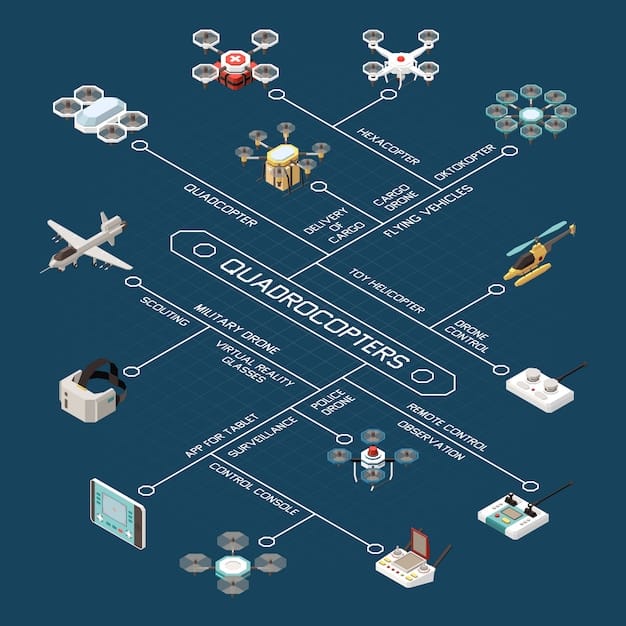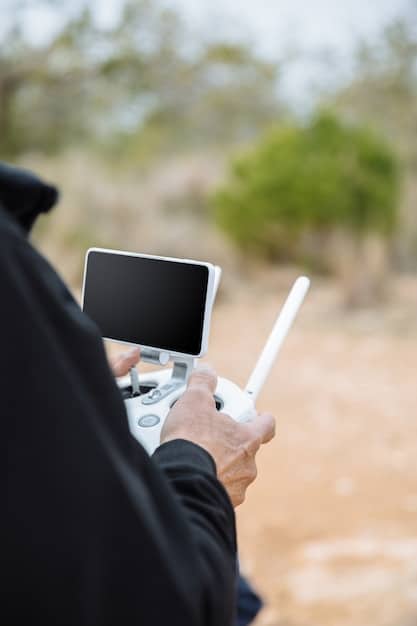UAS Regulations Update: Key Changes You Need to Know in 2024

New regulations for Unmanned Aircraft Systems (UAS), commonly known as drones, have recently taken effect in the US, impacting recreational and commercial operators by introducing updated operational requirements, airspace restrictions, and remote identification protocols to enhance safety and accountability in the national airspace system.
The landscape of drone operation in the United States is constantly evolving. Recent updates to the new regulations for Unmanned Aircraft Systems (UAS) have taken effect, bringing significant changes that all drone pilots—whether hobbyists or professionals—need to understand to ensure compliance and safe flying.
Understanding the UAS Regulatory Landscape
The regulatory framework for Unmanned Aircraft Systems (UAS) is complex, with various agencies contributing to the set of rules that govern drone operation in the United States. The Federal Aviation Administration (FAA) plays a central role, but the picture involves other stakeholders, and understanding the dynamics is critical for safe and compliant drone operations.
The FAA’s Role in UAS Regulation
The FAA is primarily responsible for the safety and efficiency of the national airspace system. In the context of UAS, its role includes developing and enforcing regulations related to drone registration, pilot certification, operational limitations, and airspace management. The FAA has been tasked with integrating drones into the existing aviation system in a way that preserves safety and minimizes risks.
Other Agencies Involved
While the FAA holds the main responsibility, other agencies also play a role in regulating UAS activities. Several government entities have a vested interest in how drones are used and what rules apply to their operations:
- Department of Homeland Security (DHS): Works with the FAA on security-related aspects of drone operations, especially near critical infrastructure and border areas.
- Law Enforcement Agencies: Local and federal law enforcement agencies have jurisdiction over drone operations that violate privacy, security, or other laws.
- State and Local Governments: States may enact laws relating to drone operations on the state and local level, like trespass, privacy, and police activities.
Understanding the involvement and jurisdiction of each agency or organization can help UAS operators navigate the regulatory environment successfully.
Key Updates in the New UAS Regulations
The recent updates to UAS regulations are substantial and affect different aspects of drone operation. These revisions touch on remote identification, operational requirements, and airspace restrictions, aiming to enhance safety, security, and accountability. Here’s a breakdown of the significant changes all drone pilots should be aware of.

Remote Identification (Remote ID)
One of the most significant changes is the implementation of Remote ID requirements. Remote ID helps in identifying drones in flight and their control stations. The FAA describes Remote ID as “the ability of a drone in flight to provide identification and location information that can be received by other parties.”
Operational Requirements
The updated UAS regulations also include revisions to operational requirements. These changes aim to make drone operations safer and more standardized, and require drone operators to:
- Maintain visual line of sight (VLOS) unless they have obtained a waiver.
- Operate within specified altitude and speed limits.
- Adhere to restrictions related to operating near airports and other sensitive locations.
- Comply with rules about operating over people or moving vehicles, depending on the category of drone and the operation.
Airspace Restrictions and Authorizations
Given the importance of ensuring orderly drone operations, the FAA has implemented measures to control where and when drones can fly. This has led to new airspace restrictions and authorization protocols, which entail the following actions:
- Understanding airspace classifications.
- Obtaining pre-flight authorizations for controlled airspace.
- Complying with temporary flight restrictions (TFRs) that may be put in place for specific events or conditions.
Operators must stay informed about where and when they can fly to uphold safety. The key updates in UAS regulations affect different categories of operators significantly, but all are geared towards making drone operations safer, more secure, and more accountable. Staying compliant ensures that drone enthusiasts and professionals alike can enjoy the benefits of UAS technology without compromising on safety.
How the Regulations Impact Recreational Drone Pilots
Recreational drone pilots, who fly for enjoyment rather than commercial purposes, are also subject to the new UAS regulations. Understanding how these rules affect hobbyist operations is crucial for recreational users to remain compliant and avoid penalties. While certain regulations might initially seem geared more towards commercial operations, recreational pilots should also observe these rules.

Registration Requirements
Like commercial pilots, recreational drone pilots must register their UAS with the FAA. The registration process ensures that drones can be traced back to their owners, enhancing accountability and safety.
Operating Rules
Recreational drone pilots face several rules regarding how and where they can operate their UAS, requiring pilots to:
- Fly within visual line of sight.
- Keep drones below 400 feet in uncontrolled airspace.
- Never operate near other aircraft.
- Follow community-based safety guidelines established by organizations like the Academy of Model Aeronautics (AMA).
Remote ID Compliance for Recreational Flyers
Recreational drone pilots must also comply with the Remote ID requirements. This ensures that drones can be identified in flight, similar to the rules that apply to commercial operators. To comply, recreational flyers have the following options:
- Fly a drone with standard Remote ID capabilities.
- Add a Remote ID broadcast module to their drone.
- Fly within FAA-Recognized Identification Areas (FRIAs).
Recreational pilots need to be aware of, and adhere to, these requirements to avoid penalties and ensure responsible participation in the drone flying community.
Consequences of Non-Compliance
Failure to comply with UAS regulations can lead to serious consequences. The FAA has the authority to impose substantial penalties for violations, including fines, suspension or revocation of pilot certificates, and even criminal charges in severe cases. Avoiding these penalties depends on understanding the nature of non-compliance, including enforcement and penalty structures.
Potential Penalties and Fines
The penalties for non-compliance with UAS regulations vary, depending on the severity and nature of the violation. Here are some examples of potential consequences:
- Civil Penalties: Fines can range from hundreds to thousands of dollars per violation. The exact amount depends on the nature of the offense and the operator’s history.
- Pilot Certificate Actions: For certified drone pilots (those operating under Part 107), the FAA can suspend or revoke their pilot certificates for regulatory violations.
- Criminal Charges: In cases of reckless endangerment or intentional violation of regulations, criminal charges may be filed, leading to potential jail time.
The FAA actively monitors and enforces UAS regulations, with increasingly sophisticated tools to detect and track non-compliant drone operations. As drone technology becomes more advanced, so does the FAA’s ability to monitor and manage drone operations, making compliance more important than ever.
How to Ensure Compliance
Ensuring compliance with UAS regulations requires continuous education and diligence on the part of drone operators. By taking the time to learn the rules, operators can keep themselves, and the airspace, safe.
- Stay Informed: Subscribe to FAA updates and follow aviation news to stay current on regulatory changes.
- Take Training Courses: Consider taking advanced training courses to deepen your understanding of UAS operations and regulatory requirements.
- Use Compliance Tools: Leverage available tools and apps that help with pre-flight planning, airspace awareness, and Remote ID compliance.
Future Trends in UAS Regulations
The field of UAS technology is constantly evolving, and regulations will continue to adapt to address new capabilities and challenges. Keeping an eye on upcoming trends and potential changes is crucial for drone operators to plan and adapt.
Anticipated Regulatory Changes
Several areas are likely to see regulatory changes over the next few years, including the following:
- Beyond Visual Line of Sight (BVLOS) Operations: As technology improves, the FAA is expected to expand opportunities for BVLOS operations, requiring advanced safety mitigations and technology.
- UAS Traffic Management (UTM): Efforts to develop a comprehensive UTM system will continue, leading to improved airspace management and coordination between manned and unmanned aircraft.
- Integration of New Technologies: Regulations will need to adapt to emerging technologies such as drone delivery services, autonomous operations, and advanced sensors.
Preparing for the Future
Drone operators can take several steps now to prepare for these future changes:
- Invest in Training: Focus on advanced training and certifications that cover BVLOS operations, risk management, and UTM concepts.
- Monitor Industry Developments: Stay engaged with industry associations, attend conferences, and follow regulatory news to stay informed.
- Engage with Regulators: Participate in public forums and workshops to provide input on regulatory proposals and contribute to the development of balanced and effective rules.
By thinking ahead and preparing proactively, drone operators can ensure they remain compliant and competitive, and contribute to the safe and responsible integration of UAS technology into the national airspace system.
| Key Point | Brief Description |
|---|---|
| 📝 Remote ID | Drones must broadcast identification and location information. |
| ✈️ Airspace | Follow restrictions and get authorization for controlled airspace. |
| 📜 Compliance | Stay informed to avoid penalties. |
| 📡 Future Trends | Anticipate new rules to better prepare. |
Frequently Asked Questions (FAQ)
Remote ID is a way for drones to broadcast their identification and location during flight to enhance safety and accountability. It allows authorities to quickly identify drone operators and ensure they are following regulations.
Commercial drone pilots must comply with Remote ID regulations, understand airspace restrictions, and obtain proper authorization. New operational rules may also require additional training or equipment to ensure safety and compliance.
Penalties can include civil fines, suspension or revocation of pilot certificates, and, in severe cases, criminal charges. The exact penalty depends on the nature and severity of the violation.
No, recreational drone pilots must follow specific rules, including operating within visual line of sight, below 400 feet in uncontrolled airspace, and following community-based safety guidelines. They must also comply with Remote ID requirements.
Drone pilots should subscribe to FAA updates, follow aviation news, attend industry conferences, and engage with regulatory agencies to stay informed about the latest changes and best practices in UAS operations.
Conclusion
Staying updated on the new UAS regulations is essential for both recreational and commercial drone pilots. By understanding and adhering to these rules, operators can ensure safety, compliance, and the continued responsible use of drone technology. Continuous education and proactive planning will be key to navigating the evolving regulatory landscape.





